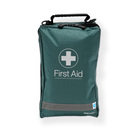Amputations and boating
Unlock This Video Now for FREE
This video is normally available to paying customers.
You may unlock this video for FREE. Enter your email address for instant access AND to receive ongoing updates and special discounts related to this topic.
Emergency Treatment for Amputations: Step-by-Step Guide
Understanding Amputations
Amputations, particularly in emergencies, are severe injuries that require immediate and appropriate care. While the likelihood of encountering such injuries, especially on a boat, is rare, it is essential to be well-prepared. **Training for the worst-case scenario** can make a significant difference.
Common Scenarios for Amputations
Amputations can range from a finger caught in ropes to more severe injuries like a hand or leg being severed. Although it is uncommon, a situation where someone falls off a boat and is struck by the propeller could result in a severe lower leg amputation.
**Key Point:** Even though such injuries are not common, they can occur, and being prepared is crucial.
Immediate Steps to Take Following an Amputation
1. Controlling Bleeding
The first priority in any amputation is to manage the bleeding. **Assess the injury and determine the extent of bleeding.** If the amputation is near the knee, a tourniquet should be applied just above the knee—never over it.
Note: Learn more about tourniquet application in our other videos.
2. Dressing the Stump
Once the bleeding is under control, the stump must be dressed to prevent infection and aid in healing. If a tourniquet is in place and bleeding has stopped, you may consider using a haemostatic dressing like WoundClots.
Step-by-Step:
- Apply a haemostatic dressing to stop bleeding and begin the healing process.
- Cover the wound with a trauma dressing to protect it from infection.
- Ensure the dressing is secure, using the stretchable material to wrap it tightly around the stump.
- Additional dressings may be necessary to cover the entire wound adequately.
3. Maintaining the Amputated Part
If the amputated part is available, it should be preserved properly for potential reattachment by a surgeon.
Preservation Tips:
- If a finger or other small part is severed, wrap it in clean film or plastic to keep it clean.
- Wrap the protected part in a towel, cloth, or T-shirt.
- Place the wrapped part in ice water, ensuring that the ice does not directly contact the tissue.
Treating for Shock
After controlling the bleeding and securing the wound, it is crucial to treat the patient for shock. Keep the patient warm and calm until professional medical help arrives.
Final Considerations
In cases where the amputated part is still partially attached, avoid damaging any remaining healthy tissue. The ultimate goal is to keep the patient stable and the injury site clean and secure until they can receive advanced medical care.
Remember: Proper training and quick action can significantly improve the outcome in amputation emergencies.


_-Trauma_8x20_CE.jpg)

_-Trauma_8x100_CE.jpg)


_-Trauma_10x10_CE.jpg)